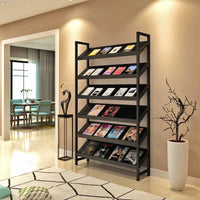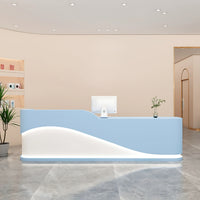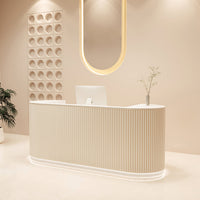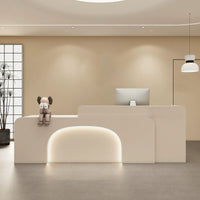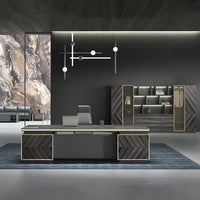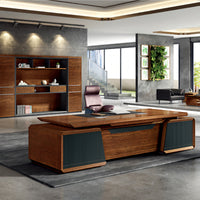How to Build Conference Table: A Comprehensive Guide for Custom Office Solutions?
kaguyasuContent Menu
● Table of Contents
● Introduction: Why Build a Conference Table?
● Materials and Tools Needed to Build Conference Table
>> Materials
>> Tools
● Step-by-Step Guide on How to Build Conference Table
>> Preparing the Workspace and Tools
>> Constructing the Tabletop
>> Building the Frame and Legs
>> Assembly and Finishing Touches
● Customization Tips for OEM Conference Table Production
● Maintenance and Durability Considerations
● Frequently Asked Questions (FAQs)
Building a conference table is a rewarding project that combines craftsmanship, design, and functionality. Whether you are a furniture manufacturer, an OEM service provider, or a DIY enthusiast, understanding how to build conference table pieces that meet client needs is essential. This article will guide you step-by-step through the process of building a conference table, highlighting key materials, tools, and assembly techniques. We will also discuss customization options to suit different office environments and brand requirements.

Table of Contents
- Introduction: Why Build a Conference Table?
- Materials and Tools Needed to Build a Conference Table
- Step-by-Step Guide on How to Build Conference Table
- Preparing the Workspace and Tools
- Constructing the Tabletop
- Building the Frame and Legs
- Assembly and Finishing Touches
- Customization Tips for OEM Conference Table Production
- Maintenance and Durability Considerations
- Frequently Asked Questions (FAQs)
Introduction: Why Build a Conference Table?
Conference tables are the centerpiece of any meeting room, symbolizing professionalism and collaboration. Knowing how to build conference table units allows manufacturers and OEM providers to deliver tailored solutions for brands and wholesalers worldwide. Custom-built conference tables can be designed to fit specific dimensions, incorporate technology integration, and reflect a company's branding through materials and finishes[4][9]. This flexibility is crucial in today's competitive office furniture market.
Materials and Tools Needed to Build Conference Table
Materials
- Wood: Solid wood (e.g., white oak, walnut) or engineered wood such as plywood or MDF for the tabletop[2][3][7].
- Metal Components: Steel or aluminum frames, angle irons, and fittings for sturdy support[2][5].
- Fasteners: Screws, bolts, and mounting hardware.
- Finishing Products: Sandpaper, wood stain, sealant, or paint for aesthetics and protection.
- Optional: Power and data hatch covers for integrated technology.
Tools
- Cordless drill and screwdriver
- Circular saw or table saw
- Orbital sander
- Angle grinder (for metalwork)
- Measuring tape and square
- Clamps and sawhorses[2][5]
Step-by-Step Guide on How to Build Conference Table
Preparing the Workspace and Tools
Set up a clean, spacious work area with adequate lighting. Organize all tools and materials for easy access. Using folding metal sawhorses can provide adjustable support for both the tabletop assembly and frame construction[2].
Constructing the Tabletop
1. Select and Prepare Wood: Choose 2x6 lumber or quality plywood sheets. Sand the wood thoroughly with 120 grit sandpaper to achieve a smooth surface[2].
2. Cut to Size: Cut the wood to the desired conference table dimensions, commonly ranging from 6 to 24 feet in length and 3 to 5 feet in width[7].
3. Assemble the Top: Join the wood pieces using wood glue and screws. Reinforce the underside with plywood strips or braces to prevent warping[2][7].
4. Finish the Surface: Apply stain or paint as desired, followed by a protective sealant for durability.
Building the Frame and Legs
1. Design the Frame: Decide on the frame style—traditional wooden legs, metal pipe frames, or industrial fittings like Kee Klamp[5].
2. Cut and Prepare Metal Pipes or Wood: Measure and cut frame components precisely.
3. Assemble Frame Sections: Build leg supports and middle braces separately, then join them together. Use swivel sockets and tee fittings for modular assembly[5].
4. Attach Casters or Feet: For mobility, add caster wheels; otherwise, install stable feet.
Assembly and Finishing Touches
1. Attach Frame to Tabletop: Use flange fittings or brackets to secure the tabletop to the frame firmly[5].
2. Wire Management: Integrate cable management systems or power strips under the table for a clean look and functionality[2].
3. Final Inspection: Check for stability, smooth edges, and finish quality.
Customization Tips for OEM Conference Table Production
- Size and Shape: Offer rectangular, U-shaped, or modular tables to fit various room layouts[4].
- Material Choices: Provide options from solid wood to metal and laminate surfaces to meet budget and style preferences[10].
- Technology Integration: Incorporate power outlets, USB ports, and data hatches seamlessly into the design[9].
- Branding: Use logo inlays, custom colors, and finishes to align with brand identity.
- Packaging and Shipping: Design knock-down packaging for efficient shipping and easy assembly at the client site[8].
Maintenance and Durability Considerations
- Use high-quality sealants and finishes to protect wood surfaces from scratches and spills.
- Regularly check and tighten fasteners to maintain stability.
- Clean with appropriate products to preserve the table's appearance.
- Choose materials that withstand daily use in commercial environments[10].
Frequently Asked Questions (FAQs)
Q1: What is the best wood for building a conference table?
A1: Hardwoods like white oak and walnut are preferred for durability and aesthetics, but plywood with veneer can be a cost-effective alternative[3][7].
Q2: How long does it take to build a conference table?
A2: Depending on complexity and size, building a conference table can take from a few days to a couple of weeks, including finishing and drying time[2][5].
Q3: Can I include power and data ports in the conference table?
A3: Yes, integrating power strips and data hatches is common and enhances functionality for modern offices[9].
Q4: How do I ensure the table is stable and level?
A4: Use sturdy frame materials, reinforce with braces, and adjust leg height or add levelers as needed[5].
Q5: What packaging methods are recommended for shipping conference tables internationally?
A5: Knock-down packaging with protective foam and sturdy cartons is recommended to prevent damage during transit[8].

[1] https://www.youtube.com/watch?v=RlCpmuoLobU
[2] https://www.instructables.com/HomeMade-Modern-DIY-Conference-Table/
[3] https://www.youtube.com/watch?v=zoDOL_j0S1k
[4] https://www.custom-conference-tables.com
[5] https://www.simplifiedbuilding.com/projects/diy-industrial-conference-table
[6] https://www.holzmedia.de/en/impressions/individuelle-konferenztischanlage-mit-zentralem-unterbau-und-optisch-schwebender-tischplatte-matsu-china-co-ltd-shanghai-2016/
[7] https://www.finewoodworking.com/forum/large-conference-table-question
[8] https://chinese.alibaba.com/product-detail/customize-odm-oem-free-sample-china-office-furniture-manufacturer-l-shaped-manager-ceo-executive-office-desk-1600217422036.html
[9] https://www.custom-conference-tables.com/about/
[10] https://www.colanworks.com/products/Conference-Table-Chair_gid-44989.html
Hot Tags: China, Global, OEM, private label, manufacturers, factory, suppliers, manufacturing company



